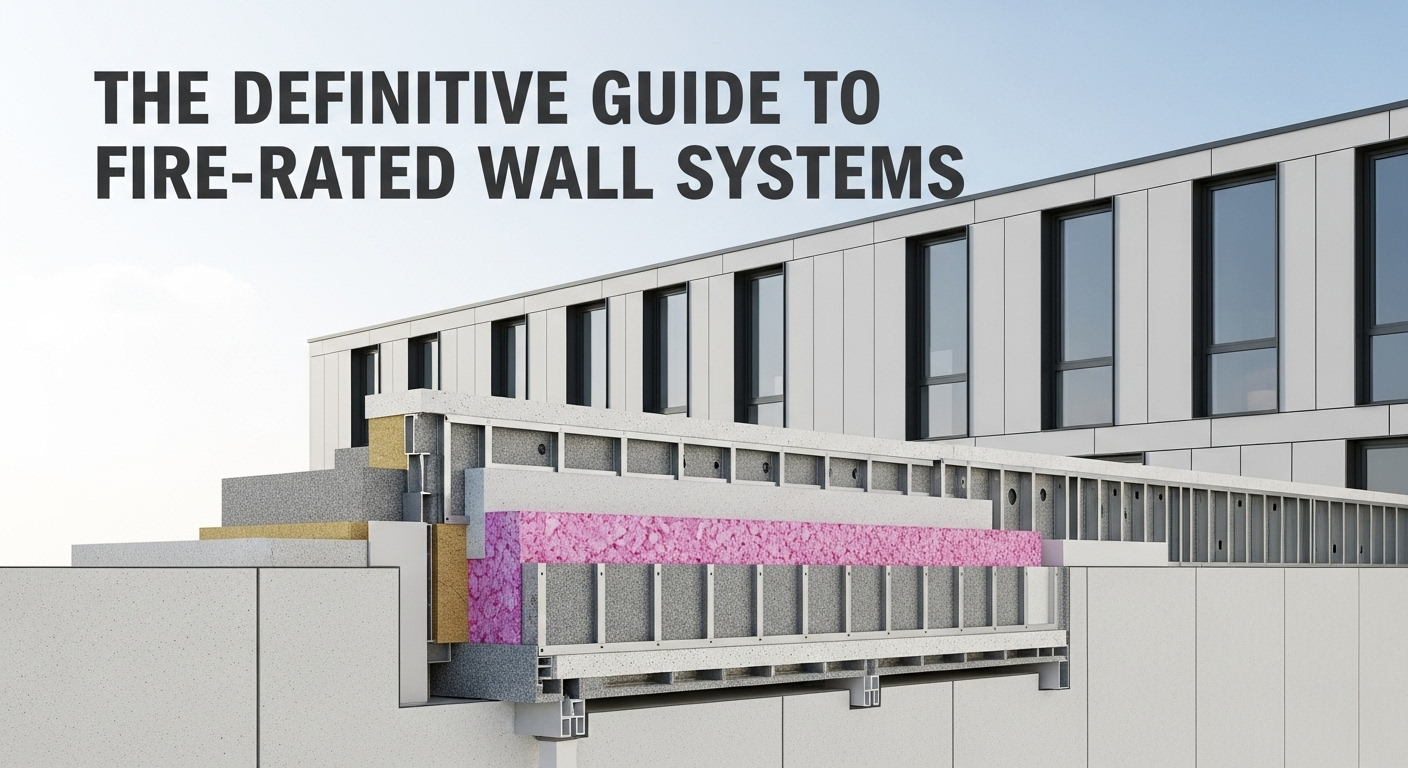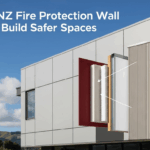The Definitive Answer: What is a Fire-Rated Wall System?
The Definitive Guide to Fire-Rated Wall Systems – At its core, a fire-rated wall system is a wall assembly that has been tested and certified to resist the passage of fire and heat for a predetermined amount of time. The key term here is “system” or “assembly.” A fire-rated wall is not simply a single material, like a special type of drywall. It is a complete, multi-component construction where every single element works in concert to achieve the desired fire-resistance rating.
The primary function of these systems is compartmentation. By dividing a building into smaller, fire-contained zones, these walls effectively slow or stop the spread of flames, smoke, and hot gases from one area to another. This compartmentalization is a cornerstone of modern fire safety design, helping to protect escape routes, safeguard critical areas, and prevent a small, localized fire from becoming a building-wide catastrophe.
A fire-rated wall system is meticulously designed to perform three critical functions during a fire:
- Maintain Structural Integrity: The wall must remain standing and stable, without collapsing under the stress of the fire.
- Prevent Flame Passage: It must not allow flames to penetrate from the fire-exposed side to the non-exposed side.
- Limit Heat Transfer: It must insulate the non-fire side to prevent the temperature from rising enough to ignite combustible materials on the other side.
Therefore, when we ask what is a fire rated wall system, the answer is an engineered assembly of specific components, installed in a precise manner, designed to contain a fire and protect life and property.

Decoding the Numbers: Understanding Fire-Resistance Ratings
The effectiveness of a fire-rated wall is quantified by its fire-resistance rating. This rating is expressed in hours (or minutes) and represents the duration for which the wall assembly can withstand a standardized fire test without failing. These numbers are not arbitrary; they are the result of rigorous scientific testing.
What Do the Ratings Mean? (e.g., 1-Hour, 2-Hour, 4-Hour)
A 1-Hour Fire-Rated Wall means the complete assembly has been tested to successfully contain a fire and limit heat transfer for at least 60 minutes. Similarly, a 2-hour or 4-hour rating indicates successful performance for 120 minutes or 240 minutes, respectively.
The required rating for a specific wall depends on building codes, the building’s occupancy type (e.g., residential, commercial, industrial), and the wall’s location and function. For instance, a wall separating two apartments might require a 1-hour rating, while a wall enclosing a critical stairwell or separating major building sections might require a 2-hour or 3-hour rating.
The Role of Testing Standards and Certification
Fire ratings are determined by subjecting a full-scale wall assembly to a controlled fire in a specialized furnace. The test follows a standardized time-temperature curve, simulating the conditions of a real building fire.
The most widely recognized testing standard in North America is ASTM E119, “Standard Test Methods for Fire Tests of Building Construction and Materials.” This standard dictates the precise procedures for the fire test and the criteria for failure. Independent third-party organizations like Underwriters Laboratories (UL) and Intertek (ETL) conduct these tests and list or certify the assemblies that pass. These listings, such as a UL Design Number (e.g., U411, U305), provide a detailed “recipe” for constructing the wall system, specifying every component and installation detail.
“Assembly” is the Most Important Word
It cannot be stressed enough that fire ratings apply to the entire assembly, not to individual products in isolation. You cannot simply buy “1-hour studs” or “1-hour drywall.” The rating is achieved by the precise combination and installation of every single component.
A typical fire-rated wall assembly includes:
- Framing: Steel or wood studs of a specific size and spacing.
- Gypsum Board: One or more layers of a specific type and thickness of fire-rated gypsum board.
- Insulation: Often, a specific type of insulation (like mineral wool) is required within the wall cavity.
- Fasteners: Screws or nails of a specific type, length, and a precise spacing pattern.
- Joint Treatment: The use of specific joint tape and compound, applied in a particular way to seal the seams between gypsum boards.
- Sealants: Application of fire-rated acoustic or firestop sealant at the perimeter of the wall (top and bottom tracks).
If any single element is changed—for example, using the wrong type of screws, spacing them too far apart, or substituting a different type of insulation—the entire fire rating of the assembly is voided.
The Anatomy of a Fire-Rated Wall: Key Components Explored
To truly appreciate what is a fire rated wall system, we must look at its individual components and understand the role each one plays in resisting fire. These materials are chosen and engineered for their specific performance under extreme heat.
Fire-Resistant Gypsum Board (Type X and Type C)
Gypsum board, often called drywall, is the workhorse of fire-rated assemblies. Its fire resistance comes from its chemical composition. Gypsum is calcium sulfate dihydrate (CaSO₄·2H₂O), meaning it has water chemically bound within its crystal structure.
When exposed to high heat, this water is slowly released as steam in a process called calcination. This process absorbs a significant amount of heat energy, keeping the temperature on the non-fire side of the panel low. The steam being driven off also helps to dilute combustible gases. There are two primary types used in fire-rated systems.
Type X Gypsum Board
Type X is the standard fire-rated drywall. It is denser and has glass fibers mixed into its gypsum core. These fibers provide additional structural integrity, helping to hold the core together as the water turns to steam and the gypsum begins to crumble. This prevents the formation of large cracks or openings through which flames could pass. A single layer of 5/8-inch Type X gypsum board is a common component in 1-hour rated wall assemblies.
Type C or “Improved” Type X Gypsum Board
Type C gypsum board offers enhanced fire resistance compared to Type X. In addition to glass fibers, its core contains vermiculite or other additives that expand when heated. This expansion helps to counteract the shrinkage that occurs in the gypsum core during a fire, further improving its integrity and ability to stay in place for longer periods. Type C is often specified in assemblies that require higher fire ratings or in ceiling assemblies where gravity is a factor.
Framing Members: Steel vs. Wood Studs
The structural backbone of the wall is the framing, which can be either steel or wood. Both materials can be used to construct fire-rated assemblies, but they behave very differently in a fire.
Steel studs are non-combustible, which is a significant advantage. However, steel loses a substantial amount of its strength at high temperatures. During a fire test, a steel stud wall may buckle or deform more quickly than a wood stud wall. The design of the overall assembly accounts for this behavior.
Wood studs are combustible, but they have an inherent fire resistance. As wood burns, it develops a layer of char on its surface. This char layer acts as an insulator, protecting the unburned wood core. For a time, the unburned core can maintain a significant portion of its structural strength. This predictable charring rate is why heavy timber structures can perform surprisingly well in a fire.
The choice between steel and wood often depends on the building type, cost, and specific requirements of the certified assembly design.
Essential Details: Insulation, Fasteners, and Joints
The performance of the system relies on details that are easy to overlook but are absolutely critical.
- Fire-Resistive Insulation: Many fire-rated walls require insulation within the stud cavity. Mineral wool insulation is a common choice because it is non-combustible and has a very high melting point. It helps to slow heat transfer through the wall cavity and can also provide acoustic benefits.
- Fasteners: The type, length, and spacing of screws are meticulously specified in a UL design. They must be long enough to penetrate the framing to the required depth, and their spacing ensures the gypsum panels are held securely to the frame even as the structure shifts and degrades under heat.
- Joint Treatment: The seams between gypsum board panels are a potential weak point. Fire-rated assemblies require that these joints be properly taped and finished with a specified joint compound. This creates a continuous, monolithic surface that prevents flames from passing through the cracks.
Installation and Maintenance: Where Theory Meets Reality
A perfectly designed fire-rated wall system is completely ineffective if it is not installed correctly or maintained properly throughout the life of the building. This is where the responsibility shifts from the designer to the contractor and the building owner.
The Critical Importance of Proper Installation
Contractors must follow the specified certified design (e.g., the UL design number) to the letter. There is no room for improvisation or “value engineering.” Every detail matters.
Common installation errors that can compromise a fire-rated wall include:
- Substituting non-rated materials for specified components.
- Using the incorrect screw length or spacing pattern.
- Improperly finishing the joints between gypsum boards.
- Leaving gaps at the top or bottom of the wall that are not sealed with a fire-rated sealant.
These mistakes can lead to a catastrophic failure of the wall system in a real fire, with severe legal and financial consequences for those responsible.

The Challenge of Penetrations and Firestopping
A wall in a real building is rarely a blank, uninterrupted surface. It must be penetrated by pipes, electrical conduits, HVAC ducts, and communication cables. Each one of these openings creates a breach in the fire-rated barrier.
This is where firestopping becomes essential. Firestopping is the process of sealing these openings with specialized materials and systems designed to restore the fire-resistance rating of the wall assembly. Firestop systems include:
- Intumescent Sealants: These caulks expand dramatically when exposed to heat, sealing off the opening.
- Firestop Collars: Devices that wrap around plastic pipes. They contain intumescent material that expands and crushes the melting pipe to close the hole.
- Firestop Pillows and Blocks: Used to seal large, temporary, or frequently changing openings, such as those for data cables.
An unsealed penetration completely negates the wall’s fire rating. It is like having a locked, fire-rated door with a giant hole cut in the middle. Firestopping is a specialized trade that requires trained installers who understand how to properly install certified systems.
The Need for Ongoing Inspection and Maintenance
A fire-rated wall system is not a “set it and forget it” component. Over the building’s life, damage occurs. A maintenance worker might drill a new hole for a cable and forget to firestop it. A forklift might damage a section of drywall in a warehouse.
Building owners and facility managers have a responsibility to conduct periodic inspections of their fire-rated barriers. Any damage, alterations, or unsealed penetrations must be repaired promptly and correctly, using the appropriate fire-rated materials and methods to ensure the system’s integrity is maintained.
Conclusion: Building a Safer Future, One Wall at a Time
A fire-rated wall is a testament to the power of systems thinking in building safety. It demonstrates that true resilience is achieved not through a single “hero” product, but through the careful integration of ordinary materials into an extraordinary assembly. Understanding what is a fire rated wall system is to understand this crucial principle: every component, every fastener, and every installation step has a vital role to play in protecting lives.
From the chemical composition of its gypsum core to the precise spacing of its screws, the fire-rated wall is an engineered life-safety system. It stands as a silent guardian, providing the most precious commodity in an emergency: time. By respecting the science, adhering to tested designs, and committing to proper installation and maintenance, we can ensure that these walls perform their critical function when it matters most, creating safer structures for everyone.






